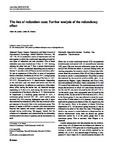The fate of redundant cues: Further analysis of the redundancy effect
| dc.contributor.author | Jones, Peter | |
| dc.contributor.author | Pearce, JM | |
| dc.date.accessioned | 2018-02-16T16:35:00Z | |
| dc.date.available | 2018-02-16T16:35:00Z | |
| dc.date.issued | 2014 | |
| dc.identifier.issn | 1543-4494 | |
| dc.identifier.issn | 1543-4508 | |
| dc.identifier.uri | http://hdl.handle.net/10026.1/10806 | |
| dc.description.abstract |
Pearce, Dopson, Haselgrove, and Esber (Journal of Experimental Psychology: Animal Behavior Processes, 38, 167–179, 2012) conducted a series of experiments with rats and pigeons in which the conditioned responding elicited by two types of redundant cue was compared. One of these redundant cues was a blocked cue X from A+ AX+ training, whereas the other was cue Y from a simple discrimination BY+ CY–. Greater conditioned responding was elicited by X than by Y; we refer to this difference as the redundancy effect. To test an explanation of this effect in terms of comparator theory (Denniston, Savastano, & Miller, 2001), a single group of rats in Experiment 1 received training of the form A+ AX+ BY+ CY–, followed by an A– Y+ discrimination. Responding to the individual cues was tested both before and after the latter discrimination. In addition to a replication of the redundancy effect during the earlier test, we observed stronger responding to B than to X, both during the earlier test and, in contradiction of the theory, after the A– Y+ discrimination. In Experiment 2, a blocking group received A+ AX+, a continuous group received AX+ BX–, and a partial group received AX± BX± training. Subsequent tests with X again demonstrated the redundancy effect, but also revealed a stronger response in the partial than in the continuous group. This pattern of results is difficult to explain with error-correction theories that assume that stimuli compete for associative strength during conditioning. We suggest, instead, that the influence of a redundant cue is determined by its relationship with the event with which it is paired, and by the attention it is paid. | |
| dc.format.extent | 72-82 | |
| dc.format.medium | ||
| dc.language | en | |
| dc.language.iso | en | |
| dc.publisher | Springer Science and Business Media LLC | |
| dc.subject | Associative learning | |
| dc.subject | Blocking | |
| dc.subject | Cue competition | |
| dc.subject | Discrimination | |
| dc.title | The fate of redundant cues: Further analysis of the redundancy effect | |
| dc.type | journal-article | |
| dc.type | Article | |
| plymouth.author-url | https://www.webofscience.com/api/gateway?GWVersion=2&SrcApp=PARTNER_APP&SrcAuth=LinksAMR&KeyUT=WOS:000349315500007&DestLinkType=FullRecord&DestApp=ALL_WOS&UsrCustomerID=11bb513d99f797142bcfeffcc58ea008 | |
| plymouth.issue | Online first publication | |
| plymouth.volume | 43 | |
| plymouth.publication-status | Published | |
| plymouth.journal | Learning & Behavior | |
| dc.identifier.doi | 10.3758/s13420-014-0162-x | |
| plymouth.organisational-group | /Plymouth | |
| plymouth.organisational-group | /Plymouth/Faculty of Health | |
| plymouth.organisational-group | /Plymouth/Faculty of Health/School of Psychology | |
| plymouth.organisational-group | /Plymouth/REF 2021 Researchers by UoA | |
| plymouth.organisational-group | /Plymouth/REF 2021 Researchers by UoA/UoA04 Psychology, Psychiatry and Neuroscience | |
| plymouth.organisational-group | /Plymouth/Users by role | |
| plymouth.organisational-group | /Plymouth/Users by role/Academics | |
| dc.publisher.place | United States | |
| dc.identifier.eissn | 1543-4508 | |
| dc.rights.embargoperiod | Not known | |
| rioxxterms.versionofrecord | 10.3758/s13420-014-0162-x | |
| rioxxterms.licenseref.uri | http://www.rioxx.net/licenses/all-rights-reserved | |
| rioxxterms.type | Journal Article/Review |


